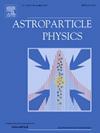噪声存在下粒子级联射电发射的能量影响及其不确定性的量化
IF 4.2
3区 物理与天体物理
Q1 ASTRONOMY & ASTROPHYSICS
引用次数: 0
摘要
测量由产生级联的天体粒子引起的无线电信号是一个挑战,因为它们总是与不可减少的噪声贡献叠加在一起。量化这些信号是一项非常重要的任务,特别是在低信噪比(SNR)下。由于噪声相位的随机性,测量结果既可以是信号和噪声的建设性叠加,也可以是破坏性叠加。为了从无线电测量中恢复级联的电磁能量,必须估计能量影响,即Poynting矢量的时间积分。传统上,时域噪声减法用于能量影响重建,在低信噪比下产生明显的偏差。在一些分析中,通过降低信噪比阈值来减轻这种偏差,尽管这种选择并不理想,因为它排除了有价值的数据。此外,即使对于较大的信噪比值,传统方法产生的不确定性也被低估了。为了解决这个已知的问题,到目前为止,不确定性通常是通过使用特别术语来近似和纠正的。这项工作通过详细介绍一种在量化无线电信号时正确估计不确定性和降低重建偏差的方法来解决这些挑战,从而在理想情况下消除了对信噪比削减的需要。该方法的开发基于强大的理论和统计背景,并且在频域中进行影响度的估计,从而通过提供频率相关影响度估计来改进进一步的分析。本文章由计算机程序翻译,如有差异,请以英文原文为准。
Quantifying energy fluence and its uncertainty for radio emission from particle cascades in the presence of noise
Measurements of radio signals induced by an astroparticle generating a cascade present a challenge because they are always superposed with an irreducible noise contribution. Quantifying these signals constitutes a non-trivial task, especially at low signal-to-noise ratios (SNR). Because of the randomness of the noise phase, the measurements can be either a constructive or a destructive superposition of signal and noise. To recover the electromagnetic energy of the cascade from the radio measurements, the energy fluence, i.e. the time integral of the Poynting vector, has to be estimated. Conventionally, noise subtraction in the time domain has been employed for energy fluence reconstruction, yielding significant biases at low signal-to-noise ratios. In several analyses, this bias is mitigated by imposing an SNR threshold cut, though this option is not ideal as it excludes valuable data. Additionally, the uncertainties derived from the conventional method are underestimated, even for large SNR values. To address this known issue, the uncertainties have so far typically been approximated and corrected by using ad-hoc terms. This work tackles these challenges by detailing a method to correctly estimate the uncertainties and lower the reconstruction bias in quantifying radio signals, thereby, ideally, eliminating the need for an SNR cut. The development of the method is based on a robust theoretical and statistical background, and the estimation of the fluence is performed in the frequency domain, allowing for the improvement of further analyses by providing access to frequency-dependent fluence estimation.
求助全文
通过发布文献求助,成功后即可免费获取论文全文。
去求助
来源期刊

Astroparticle Physics
地学天文-天文与天体物理
CiteScore
8.00
自引率
2.90%
发文量
41
审稿时长
79 days
期刊介绍:
Astroparticle Physics publishes experimental and theoretical research papers in the interacting fields of Cosmic Ray Physics, Astronomy and Astrophysics, Cosmology and Particle Physics focusing on new developments in the following areas: High-energy cosmic-ray physics and astrophysics; Particle cosmology; Particle astrophysics; Related astrophysics: supernova, AGN, cosmic abundances, dark matter etc.; Gravitational waves; High-energy, VHE and UHE gamma-ray astronomy; High- and low-energy neutrino astronomy; Instrumentation and detector developments related to the above-mentioned fields.
 求助内容:
求助内容: 应助结果提醒方式:
应助结果提醒方式:


